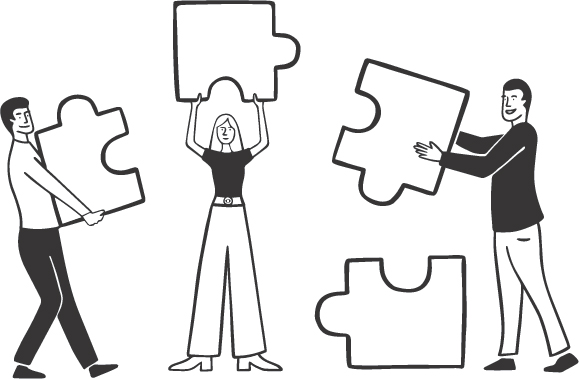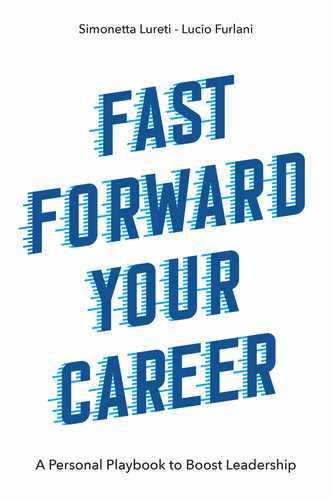Tuesday.
The team meeting went very well. The greater clarity about the goals gave everyone a sense of direction.
Everyone in the team is now at work leveraging their strengths. On paper, it is not different than before: Since the beginning Katherine had been careful to assign tasks that were as close as possible to individual experiences, but now something has clicked for each one, a motivation that wasn’t there before.
Even Elisabeth agreed with the stated goals and she started working in teamwork with the others. Finally, she feels that her seniority is recognized and she is conscious that she can move autonomously in the area where she can add the highest value.
Mark and Maurice already had high motivation before, but now their influence is more effective. Nobody is anymore questioning the importance of listening to the market, partners, and customers. Their contribution has become more precise and cutting edge because they use the project objectives to focus their research work.
And now that the objectives are clearer and the climate is collaborative, Elisabeth has proved to be a precious and respected critic. Maurice shared that it was thanks to one of her insights that Mark and he went to investigate an aspect previously neglected. And this sparked a discovery that seems to be the key to redesigning the channel incentive system.
James feels part of the group. He is more self-confident; he feels that there is no prejudgment about his ideas, but only the desire for him to contribute to the success of the project.
Katherine keeps Andrew regularly informed and he seems to like the direction the project is now taking. Katherine’s days are more productive and this reflects on her mood.
Even at home. After dinner, after clearing the table, Luke rushes to his room to play some video games. Thomas and Katherine are left alone: “How did it go today? From your face, I would say that last week’s problems are being sorted out?”
“I would say so, eventually. I’m happy with how things are going at work. It is as if the engine has finally started up and it is now running at full speed.”
“Are you talking about your team?”
“Yes, but not only that. The same is true for how we interlock with the other functions and the other business processes. The interesting thing is that it looks like we have created a virtuous circle. I wasn’t expecting it, even if, with hindsight, it is quite logical.”
“What is that?”
“The executives talk to each other. The more they have the opportunity to see the project and give their opinion, the more likely they are to talk about it with a colleague or with their team and this generates further connections and points of view. Managers and teams that I did not even know existed are now calling me to find out more and offer collaboration.”
“In mechanics, it’s called momentum. It is the mass of an object multiplied by its speed,” smiles Thomas who is a manager in a mechanical company.
“Ah, I thought it was called luck...”
“Why luck?”
“Because I still don’t understand what I did, or if something happened independently of me that triggered this virtuous circle.”
“The credit is all yours and you should take it, Katherine. Based on what you told me last night, you ‘simply’ created the conditions that are most favorable for collaboration. And it’s not that simple.”
“But... what have I done?” laughs Katherine.
“You have done 2 things that may seem contradictory, but they are not: You have created a team, which moves together toward one goal, with consistent and shared metrics, the same sense of urgency. And at the same time, everyone in the team has their own space, which fits with their own way of being and working, which is different for each of us.”
“Are you saying that we are all in the same boat, but one is at the helm, one is at the sails, one is maneuvering the anchor, and so on?”
“More or less, but with a specific rationale. Being all in the same boat, of which everyone knows the direction is fundamental. But you also put at the helm those who best know the sea currents, at the sails those who have a sixth sense for the winds... so everyone contributes to the best of their abilities because they are in the right role, they enjoy it, they feel that their contribution is important and appreciated. Everyone, being the expert in a given area, knows that they have the right degree of autonomy, or confidence if you prefer, in tensioning the rigging or whatever else they have to do.”
“Yes, there is a lot of mutual respect and a lot of trust in the team now.”
“You created it. It is the leader’s job and you did it very well, even if you may not even have noticed it… Shall I make you some limoncello to celebrate?”
“Go for the limoncello.” Katherine smiles and happily awaits the prize for her first, unexpected success.
Deep Dive—Collaboration and Teamwork
Now more than ever, teams are called upon to collaborate. Now more than ever, the limitation of independence, the uncertainty for the future, the logistical and cultural distance create fear, difficulty, disengagement. Now more than ever, executives play an important role in building a collaborative environment and transferring a functional way of working together. Neuroscience and sociological studies show that our brains respond to the ancestral threat–reward mechanism. Every human being, rationally or irrationally, tends to shy away from everything that interprets as a threat and work to maximize the rewards. There are 5 levers (triggers) that can be activated positively, and be interpreted as a reward, or negatively, and be perceived as a threat.
The 5 levers, known under the acronym SCARF, are:
• Status: Is the relative importance to others, is the seniority. The exclusion from a project, the lack of responsibility, the assignment of trivial tasks misaligned with personal experience are interpreted by our brain as a threat to our state and seniority. On the contrary, positive feedback and, above all, public recognitions are associated with awards.
• Certainty: Is the ability to predict the future. In the presence of inconsistency, lack of clarity on the arguments which justify a request, or uncertainty about the executive’s expectations, the brain focuses on the search for truth, wasting energy and resources. On the contrary, reassuring collaborators—clarifying expectations, anticipating meeting objectives, breaking project objectives into sub-objectives—reassures and allows individuals to focus on their work.
• Autonomy: Is the perception of being able to control ourselves and our actions, having the freedom of choice. Being responsible for and able to make decisions on a project, for example, increase involvement and engagement. Receiving detailed instructions on how to operate (e.g., here’s what you need to do...) limits problem solving, creativity, and learning and generates frustration.
• Relatedness: Is an affiliation. It is feeling part of a group and therefore safe in the presence of others (self-confidence). Being by collaborators’ side, limiting hierarchical distance, and supporting collaboration within the team (instead of competitiveness) create a safe environment, in which to freely propose opinions and ideas.
• Fairness: Is honesty, which manifests in impartiality, in the absence of preferences and judgment, in openness and inclusion. The executive must be impartial toward all team members. The concept of fairness is also linked to that of trust.
The executive can, however, operate the 5 SCARF in either a functional or a dysfunctional way:
• The functional way will create an environment based on trust and fairness, open to constructive confrontation and diversity of opinions (see Figure 8.1). It will reward commitment and responsibility; learning will be collective; and results will be achieved as a consequence of effective teamwork, rewarded as part of continuous growth. Neurologically, behaviors that can be interpreted as rewards trigger the production of oxytocin and dopamine with a scientifically proven improvement in creativity, proactivity, problem solving, productivity, motivation, and happiness. Leveraging SCARF functionally will allow guaranteeing effective and sustainable teamwork over time.

Figure 8.1 SCARF-based collaboration
Credits: Sebastiano Boni
• The dysfunctional way manifests, for example, in micromanagement or demotion. It may be a habit so ingrained in the leader that it is not even rationalized. The dysfunctional activation of one or more SCARF raises the level of cortisol and generates stress, frustration, disengagement. For example, if executives want to maintain responsibility for every activity, even if operational, their collaborators will not feel motivated to give their best because, in any case, they are not responsible for results.
Increasing mindfulness in their actions, paying attention to reactions, and asking and listening to collaborators allow executives to correct their behavior and promote a way to work based on fairness, sense of belonging, accountability, safety, and acknowledgment of the success achieved by the team.
